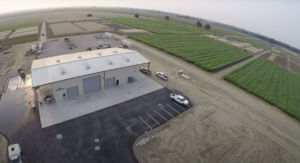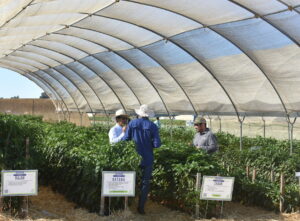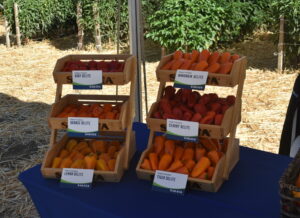Growing Together Fall 2024
Grow West Partnership Fuels Innovative Seed Research at Woodland Facility
Producing seed for 40 crops — whether for large-scale commercial production or backyard gardening — is on its own a massive endeavor. Doing so while staying on the cutting edge with the latest genetics that can withstand a growing list of environmental stressors takes the job to new levels of complexity. When Sakata® Seed America, a global leader in producing a range of vegetable seeds, needed a new facility to anchor its seed research and production, it needed a mix of optimal growing conditions and the right people to operate and manage the entire process. So the company’s leaders looked no further than Woodland, California.

Today, the Sakata Woodland Innovation Center houses most of the Japanese company’s seed research and development work. The 100-acre facility recently became the U.S. headquarters for the company previously based in Morgan Hill, California. A team of agronomists, site managers and field workers test dozens of crops and varieties to identify the highest-value innovations the company can deliver to commercial and hobby growers around the world. Breeders and the Woodland team test new varieties at the Sakata facility and once they’ve reached the necessary criteria, the seed is distributed to area growers to ramp up production for commercial growers. Then, it’s marketed through a network of more than 400 distributors throughout the U.S. and Canada alone.
Side-by-side seed research and production
The Sakata team in Woodland does more than just tend to a large number of crops. Breeders often want to see how different seed varieties will perform under ideal growing conditions. They also want to experience how different stressors will influence the quality and output of a crop. So as Sakata Seed Agronomist Adam Klingler will tell you, his job can be unique — and sometimes uniquely challenging.
“Breeders will tell me when they want us to plant a plot, then they may want to see it water-stressed or overwatered to give the crop powdery mildew so we can document how the crop handles it. Insect-wise, they may want to try biologicals or leave a crop untreated to see how the plant reacts. It can get tricky,” said Klingler, who’s been an agronomist at Sakata for around three years. “We produce the crops basically how a commercial grower would, so we do things that are most commercially viable and fit within crop budgets.”
That’s where Andrew Rumsey comes in. He’s a Grow West PCA who works with Klingler and Sakata Woodland Innovation Center Site Manager Garrett Fricke to manage both the 60-acre research portion of the farm as well as the 40 acres devoted to stock seed production. Whether for research or commercial production, Rumsey works alongside the Sakata team to ensure they achieve the right outcomes, whether it’s maximum seed production or a specific response to a pest or disease.
“The research side is all around genetics and plant breeding, seeing what works, taking quantitative measurements and cherry-picking the ones that might have promise in the commercial seed market. On the production side, we will grow stock seed that will be distributed to growers in the area to scale up on promising genetics, then grow seed to get in commercial growers’ hands and garden centers,” Rumsey said. “It’s definitely a worldwide brand, and it depends on a lot of Grow West customers who grow seed for Sakata. We know the genetic component of agriculture is a big part of the future, and many of the solutions to problems we deal with today will come from new genetics.”
Why Grow West and Sakata make strong partners in seed production and research
Grow West and Sakata Seed have a “connected relationship” in accomplishing the global seed producer’s goals. Rumsey sees his job to not just ensure maximum crop quality and productivity but also achieve specific outcomes. That may mean maximum production. It also may mean a crop that fails in the face of specific pressures. It makes the PCA in Rumsey sometimes cringe when he has to set up a crop to fail so breeders can move a step closer to an ideal variety.

“My job is to serve the research. It’s different than normal PCA work, for sure. But in this case, the breeder or person doing the research is the lead and they’re telling us what they’re looking for. We observe and communicate what we find depending on the objective of the trial,” said Rumsey, who’s worked with Sakata since 2012. “Sometimes the research work is counterintuitive to a commercial seed setting. But in order to identify the best commercial varieties, we have to make sure they can withstand common stressors in the field.”
The 60-acre research portion of the Sakata facility in Woodland is broken up into 3 ½-acre parcels that are often broken up into smaller blocks housing different crops or varieties of the same crops. Some are planted during optimal timeframes while others are tested for hardiness when planted at less desired times. Other field operations like fertilizer applications are also conducted at different times to test crop response.
“Just on the stock seed foundation side, we have nine different crops in 80 plots across 40 acres. But on the research side, it’s a lot more complicated; we may have one block that’s beets, then next to it is a block of tomatoes, then beans, eggplant, then back to beets,” Klingler said. “On the stock seed side, all the watermelon, peppers and tomatoes are planted on specific dates. But on the research side, I may split a block of watermelon into three different planting timeframes. We have a whole range of planting dates, and I have to remember when I have applied nitrogen to each block so I don’t duplicate applications. That’s where it can get difficult.”
Communication drives seed innovation and production
Conducting those field operations is one thing, but documenting results is something totally different. It takes a lot of coordination between Rumsey, Klingler and the plant breeders involved. Communication is hugely important to ensuring accurate results so the optimal varieties are moved into commercial production.
“Breeders are trying to achieve specific research objectives or are looking for a certain quality of seed. We are in constant communication on things like our plans for fertilizer and crop protection applications. And we conduct at least weekly visits to walk the smaller parcels and make recommendations depending on the field conditions and research objectives,” Rumsey said. “Sometimes these breeders want to see how genetics respond to specific pressures, whether disease or insect, so it’s different from the commercial world at times. Sometimes they want each variety’s performance to be a full expression of its genetic potential without outside pressures. We treat those blocks a little more aggressively with the idea that anything that comes from that trial will be truly representative of genetics.”

Looking ahead, Rumsey and Klingler — who along with Fricke are Woodland-area natives — expect the Sakata Woodland Innovation Center to continue growing both in size and the number of crops its team manages for both research and commercial seed production. An expansion of acres is already in the plan for next year. While Klingler and Fricke manage the seed varieties that are potentially commercially attractive to their breeders, Rumsey will continue to provide service as their PCA. While there’s a lot of growth in the plan moving forward, the way the Grow West and Sakata teams work together will remain rooted in innovation, collaboration and a focus on growers’ needs in the future.
“Scientists figure things out and cowboys make stuff happen. I’m a mix of a scientist and cowboy. We have to figure stuff out and make stuff happen here. Sometimes, there’s this push and pull between geneticists, breeders and the team managing the research plots,” Rumsey said. “We have to ensure we’re testing these crops in realistic growing environments because we want them to be successful in a commercial setting down the road. It’s all got to tie back to what the grower needs, and we have to keep that end-user in mind all the time.”
